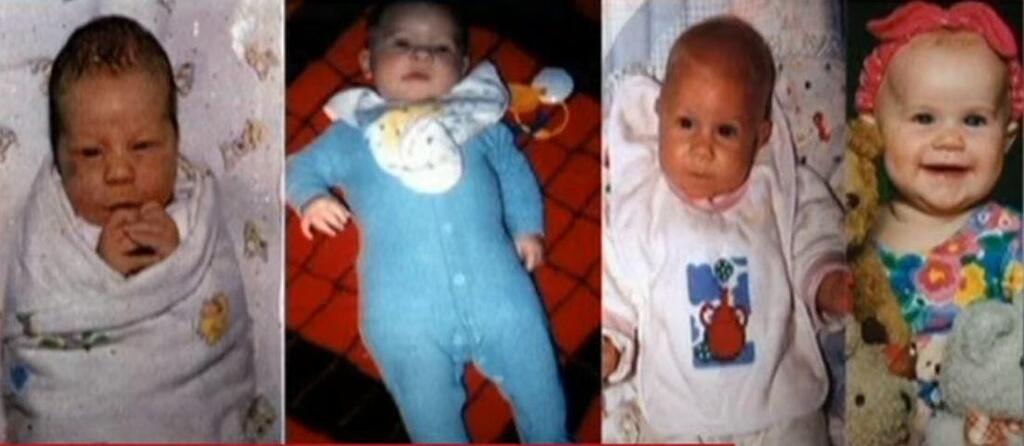The law of large numbers states that given large enough numbers, even highly unlikely occurrences can take place. The most notable examples include games of chance such as lotteries. Designed such that an individual's chances of winning are astronomically low, it seems illogical to participate. And yet, many do and a few even strike gold. The game is designed such that the chances of each individual gambler to win are so miniscule that there seems to be no practical reason to even try.
Read more:
And yet, many do gamble and few even strike gold. Why? Because when there are millions of participants in a game, even highly improbable scenarios like winning the lottery will happen from time to time. The same is true for medical treatments and drug use. Nearly every common medication carries exceedingly rare side effects, which each individual user usually has no practical reason to fear. But since the medicine is distributed en masse, sooner or later an unlucky person who suffers from a rare complication will inevitably surface.
In reality, there are many scenarios where the probability of them occurring is so slim, we mistakenly tend to think that they are impossible. Sometimes the alternative explanation that we find, or make up, might be fateful. Such is the story of Kathleen Folbigg, an Australian mother who lost the lottery of life one time too many.
Between tragedy and murder
Caleb Folbigg, born on February 1st, 1989, was the firstborn son of young Australian parents, Kathleen and Craig. The baby’s breathing seemed somewhat labored, and doctors diagnosed him with a mild case of stridor. The parents were reassured that this condition would resolve on its own, but at the age of 19 days, Caleb shut his eyes and never woke from his sleep. His death was classified as another case of the all-too-familiar sudden infant death syndrome (SIDS).
The grieving parents picked up the pieces and on June 3rd, 1990, Kathleen gave birth to their second son, Patrick. At the age of six months, the father woke up to the sound of screams. Racing to the nursery, he found his wife standing and clutching their breathless baby. Although hospital staff were able to resuscitate Patrick, he died of an epileptic seizure four months later. The couple was devastated.
4 View gallery


An Australian mother served twenty years in prison for murder of her four children. Behind bars
(Photo: Netta Kasher using Midjourney)
A year and a half later the Folbiggs welcomed a baby girl, Sarah. Tragically, she too met an untimely end at just ten months of age. Two years later their fourth child, Laura was born. She reached the age of 18 months before she too was found lifeless. Both children had appeared completely healthy, leaving behind no apparent explanation for their tragic deaths. Lightning had struck this family on four separate occasions.
In the mind of Craig, the father who had endured the loss of all of his children, one by one, alarm bells rang loudly. What were the odds that four children from the same family would pass away at such a young age with prior warning signs or any apparent medical reasons, except for Caleb’s mild stridor? In each case, Kathleen was the one who discovered the lifeless children. Upon going through her personal journal, Craig encountered expressions of remorse for their children’s deaths. The couple grew apart, ultimately divorcing, and Craig decided to report his concerns to the police. Kathleen was arrested and subsequently put on trial in 2003.
What were the odds that four children from the same family would pass away at such a young age with prior warning signs or any apparent medical reasons, except for Caleb’s mild stridor? In each case, Kathleen was the one who discovered the lifeless children
During her trial, the prosecution's central argument could be summarized as follows: “One case of sudden infant death syndrome is a tragedy; two cases raise suspicion; and three points to murder, unless proven otherwise”. This reasoning is known as Meadow’s law, named after the British pediatrician Sir Roy Meadow, a specialist in child abuse.
The legal argument is grounded in statistics: sudden infant death syndrome is considered a rare occurrence, with an estimated frequency of one in several thousand live births per year. The likelihood of such an event occurring twice within the same family is close to zero, leading to the assumption that the infants’ death can be attributed to abuse, negligence or murder. Attorneys and social workers assert that in such cases, it is more prudent to presume that other children in the family are also at risk and to consider removing them from their parents’ care.
After all, the chances of such a household being entirely healthy are exceedingly slim: about one in a hundred million. This approach has led to the dissolution of families and the incarceration of parents, a course of action that may be warranted in some cases, but not always. Nonetheless, if there exists an unidentified genetic or environmental risk factor within the family, it could substantially increase the level of risk.
Kathleen pleaded innocence. The defense presented alternative medical explanations for the death of the four infants. However, the apparent coincidence seemed too significant and implausible. Following a seven-week trial, the court ultimately deemed Kathleen Folbigg a child murderer, sentencing her to forty years in prison without the possibility of parole. Throughout her years behind bars, Folbig continued to assert her innocence and appealed her conviction, claiming that all her children died from natural causes, but to no avail. Her appeals were consistently denied.
The lightning struck four times
Since the conviction, significant advances have taken place in forensic science. DNA testing, in particular, has become more sophisticated and accessible both in terms of technology and affordability. In 2018, after spending 15 years in prison, Folbigg’s lawyers made another attempt to prove her innocence. This time they turned to immunologist Carola Garcia de Vinuesa of the Australian National University and asked for her help in finding potential genetic evidence that may point to a hereditary condition in the children.
Vinuesa conducted an extensive genetic examination that included whole genome sequencing of the mother and the children. She turned to the father as well, but he refused to cooperate. The examination revealed that both daughters carried a rare and fatal mutation in the CALM2 gene, which is involved in various aspects of cellular calcium conductance.
4 View gallery


In 2018, Folbigg’s lawyers turned to an immunologist, who performed an extensive genetic examination. A researcher examining DNA sequences
(Photo: Monika Wisniewska, Shutterstock)
Its impairment leads to the production of a defective protein, potentially leading to problems in cardiac activity and cardiac arrest at a young age. In the case of the boys, the examination revealed two defective versions of the BSN gene, which are associated with epilepsy. One defective gene copy was definitely inherited from their mother, and the second defective copy likely came from their father. Therefore, it is possible that the combination of the two defective gene copies from the two parents led to tragic outcomes.
The lawyers presented these findings to the court and requested a retrial for Folbigg. The court initially rejected the request, stating that these findings were insufficient to cast reasonable doubt regarding her guilt, primarily due to the challenge in establishing a medical link between the mutations and the causes of death. It still seemed more probable that the mother was responsible for her children’s deaths rather than attributing their deaths to the discovered rare genetic mutations.
Only after prolonged public pressure, which included medical opinions and a petition signed by dozens of scientists and doctors, was the legal discussion surrounding the conviction renewed. During these proceedings, in light of the genetic evidence, the prosecuting attorney was forced to admit that there existed reasonable doubt regarding her guilt. On June 5th, 2023, Folbigg was exonerated and was released from prison after twenty years of incarceration.
A scientific triumph
In 2003, following a 13-year international effort that cost about three billion dollars, the massive Human Genome Project was successfully completed. That was also the year in which Folbigg was tried and convicted, thus clearly the tools necessary for her acquittal simply did not exist at the time. Over the ensuing years, the technology has improved significantly and its cost was drastically reduced. Many laboratories around the world now conduct such tests routinely, at the cost of a few hundred dollars per test. From a sample of DNA - the hereditary material - that can be easily extracted from any living tissue, even post-mortem, DNA can be sequenced in its entirety, enabling a search for anomalies.
The chances of being a carrier of the mutation likely responsible for their two young daughters deaths is one in 35 million, an exceptionally rare occurrence
While our understanding of the human genome - an individual’s entire genetic material - is rapidly expanding, it is still far from complete. Fortunately for Folbigg, the mutations detected in her and her children were in vital genes with established functions. Had the mutations been situated in less studied regions of the DNA sequence, it is likely that her conviction would have remained uncontested.
It is not the first time that DNA testing has assisted in acquitting people who were wrongfully convicted of murder. However, most of these cases involved convictions pre-dating the 1990s, a period preceding the judicial system’s broad recognition of the undeniable weight of DNA evidence.
In the United States, an ongoing initiative named “Innocence Project'', seeks to re-examine preserved genetic evidence from past criminal investigations to determine whether they may contain new information that could overturn the convictions of innocent individuals. As of the time of writing of this text, 243 people have been acquitted through this project. Five percent of these exonerees were pressured into confessing guilt in their original trial, even though they hadn’t committed the crime in question, and a tenth of them were sentenced to death.
Reasonable doubt
In the case of the Folbigg couple, a double coincidence occurred. The chances of being a carrier of the mutation likely responsible for their two young daughters' deaths is one in 35 million, an exceptionally rare occurrence. In fact, it is so rare that only 135 patients carrying this mutation have been documented, although it is plausible to assume that additional surviving carriers remain undiscovered. It is enough for one of the parents to be a carrier of the mutation for it to appear in 50% of their offspring. Here, the statistics worked as expected, and two of the four children inherited the defective gene from their mother.
In the case of the two sons, the coincidence is a different one. While the frequency of the defective gene that likely led to their deaths is low, the mutation is not exceedingly rare - affecting one in every 24,000 individuals. In this case, two copies of the mutation must be present for the condition to manifest. To the boys’ great misfortune, both parents were carriers of the mutation and passed it on to them. This is a combination of circumstances with almost zero probability, but the evidence is clear-cut. There is a logical medical explanation for the infants’ deaths.
While the frequency of the defective gene that likely led to their deaths is low, the mutation is not exceedingly rare - affecting one in every 24,000 individuals
This begs the question: What defines reasonable doubt? Kathleen Folbigg’s conviction hinged on the argument that the likelihood of all four of her children dying from natural causes was so minuscule that it was essentially deemed non-existent. Yet, as her story demonstrates, even a slim probability still leaves room for the improbable occurrence to take place.
In reality, any event we encounter is inherently rare, as it is made possible by a long chain of events that led to it. While a tragedy with a one in 73 million chance may not affect the tens of millions of individuals it bypasses, for the individual who bears the unfortunate outcome, it becomes a certain and agonizing reality. And so “In the end it’s not about these variations being very rare in the world, it’s about the chances of Kathleen meeting someone like Craig and having this combination of mutations between both of them. Once genetics come into play, statistics go out the window,” summarized Vinuesa.
Naturally, there is still a chance that the infants were indeed murdered. All we know is that the existing medical evidence does not allow us to conclusively determine this. What is clear is that if we hadn’t learned to sequence the genome, Kathleen Fulbigg would spend the rest of her life in prison. Scientific developments in the field of genetics and their accessibility, alongside the efforts of scientists and doctors to uncover the truth, made her acquittal possible, albeit two decades late.



